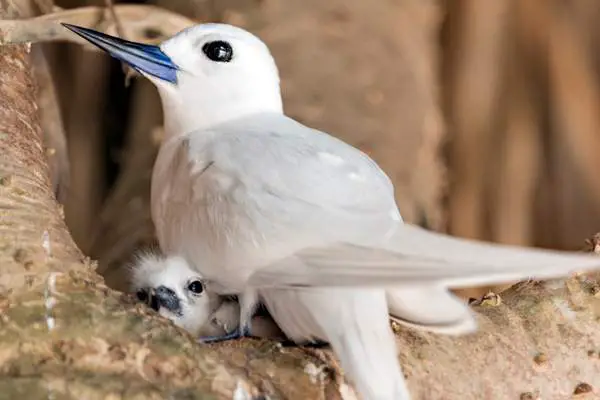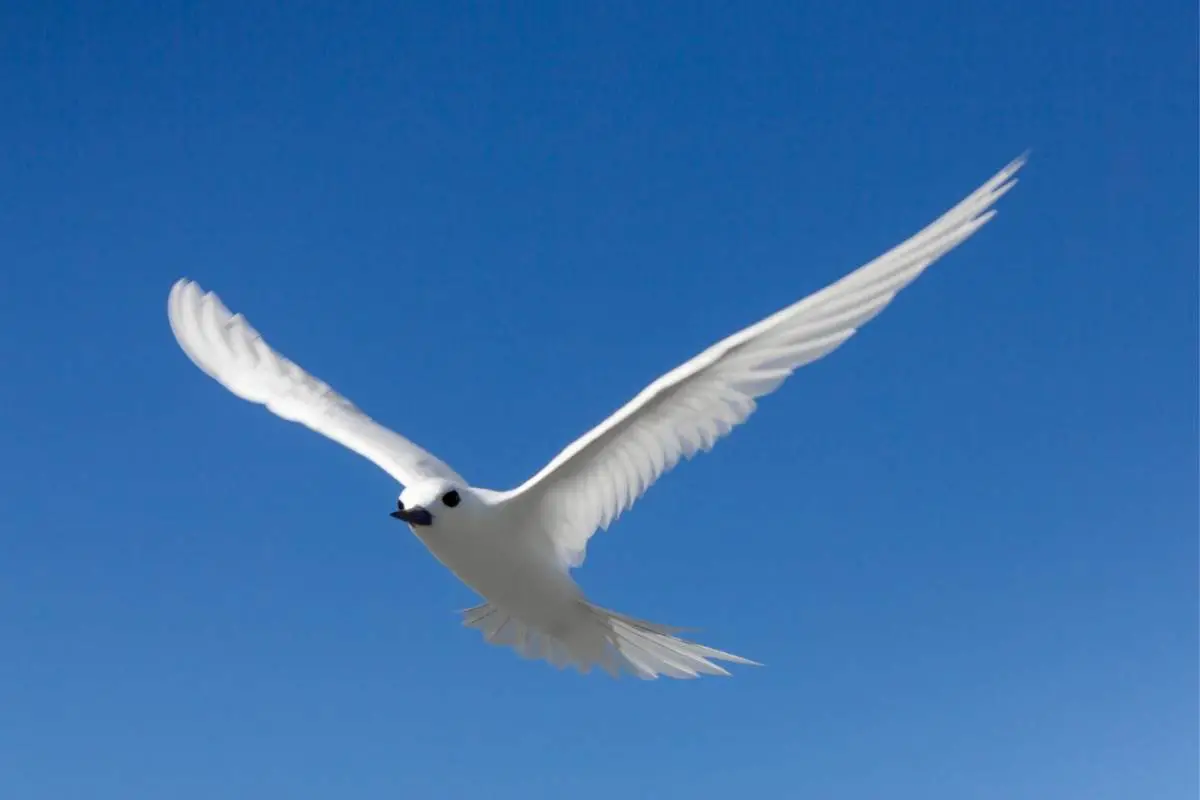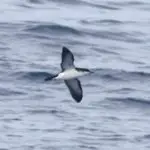Common Name: White Tern
Scientific Name: Gygis alba| Size | Diet | Range in Hawaii | Status in Hawaii |
|---|---|---|---|
| 27 in. - 34 in. | small fish and squid | All Islands | Least Concern |
The White Tern, also known as the Fairy Tern or the Common Tern, is a small, graceful seabird that is native to tropical and subtropical regions around the world.
White Tern
Appearance

The White Tern is a small seabird, with a body length of about 30 cm and a wingspan of around 50 cm. As its name suggests, it is predominantly white in color, with a glossy, smooth plumage that is almost transparent in the sunlight. Its wings are long and slender, with a slight curve at the tips, and it has a short, forked tail.
Its bill is thin and pointed, with a black tip, and its eyes are dark and beady. The legs and feet of the White Tern are also black, and the toes are long and slender, with sharp claws that are used for grasping onto branches and ledges.
Diet
The White Tern is primarily a marine bird, feeding on small fish, squid, and other marine animals that it captures while flying over the ocean. It feeds both during the day and at night, and will also occasionally feed on insects, crustaceans, and other small invertebrates that it finds on the water’s surface or washed up on the shore.
Behavior
White Tern is a highly adaptable and adaptable species, able to thrive in a wide range of marine environments and to adapt to changing conditions. It is also a highly intelligent and resourceful bird, with a range of behaviors that allow it to survive and reproduce successfully in its habitat.
Nesting

The White Tern is known for its unique nesting habits, as it is one of the few bird species that builds its nests on small, precarious ledges and branches rather than in trees or on the ground. This behavior is thought to be an adaptation to the lack of suitable nesting sites on many of the small, rocky islands that the White Tern inhabits.
The White Tern nests in colonies, with several pairs often nesting close together on the same ledge or branch. The male and female work together to build the nest, which is a simple structure made of twigs and other debris. The nest is usually quite small, barely large enough to hold the single egg that is laid.
Once the egg is laid, the male and female take turns incubating it, with the male usually doing the majority of the incubation. The incubation period is about 30 days, after which the egg hatches into a downy chick. Both parents help to feed and care for the chick, which fledges (leaves the nest) after about six weeks.
The White Tern often nests in areas that are exposed to strong winds and salt spray, and its nests are often at risk of being washed away by storms or high waves. To protect the eggs and chicks, the parents will frequently incubate them under their bodies to keep them warm and dry. They will also shelter the chicks under their wings during storms or when the weather is cold or wet.
Habitat
The White Tern is a tropical and subtropical seabird that is native to a wide range of marine environments, including coral reefs, atolls, and offshore islands. It is also found in a range of coastal habitats, including mangroves, seagrass beds, and sandy beaches.
Range
The White Tern is a widespread and common species in Hawaii, and is found on many of the islands in the archipelago.
Conservation Status
The white tern is considered to be a species of “least concern” by the International Union for Conservation of Nature (IUCN). This means that the species is not currently facing any significant threats and is not considered to be at risk of extinction
Interesting Facts
1. They are migratory bird
White Terns are migratory species, moving between its breeding and non-breeding ranges depending on the season, and may travel long distances in search of suitable habitat and food.
2. They are highly skilled flyer
The White Tern is a highly skilled flyer, able to glide effortlessly over the ocean in search of small fish and other marine animals to feed on. It is also a vocal bird, with a distinctive, high-pitched call that is often heard near its nesting colonies.
3. Usually silent
White terns make a repeated guttural “heech-heech”. At the nest site, they are usually silent.
4. They are also called “fairy terns”
White terns are also called “fairy terns” due to their delicate features and their zipping, “skipping,” and hovering overhead.
5. White Terns population
The White Tern is a widespread and relatively common species, with a global population that is estimated to be between 500,000 and 1 million individuals.
Frequently Asked Questions
How long does a White Tern live?
The White Tern is a long-lived species, with a lifespan that can exceed 20 years in the wild. However, the average lifespan is generally shorter, with many individuals living for only a few years.
How far can a White Tern fly?
White Tern is able to fly long distances without stopping, and is able to cover large distances in a relatively short period of time. it moves between its breeding and non-breeding ranges depending on the season, and may travel many hundreds or even thousands of kilometers between these ranges.
How heavy is a White Tern?
It is a relatively lightweight bird, with a body weight that ranges from about 60 to 120 grams, depending on the size and condition of the individual.




